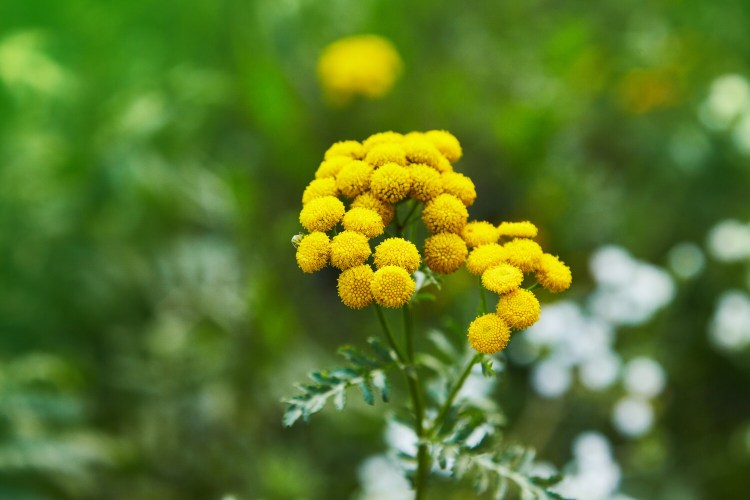Back in December when it had been snowing and I had just begun to miss being out in the garden, an email from Pinetree Garden Seeds in New Gloucester caught my attention.
The email linked to a blog written by Pinetree staff that explained that not all bugs are bad, and that some plants have the ability to attract good insects that will fight the pesky ones. Other plants repel pesky insects and even, in some cases, mammals such as deer.
The blog recommended one plant that Pinetree and other Maine seed sellers don’t stock: tansy. We grew it near our back door when we first moved into our house, but when we built an addition to the house, that spot became part of our family room.
Tansy, with the botanical name Tanacetum vulgare, will grow up up to five feet tall, produce yellow, button-like flowers from August until October and is extremely low maintenance. When it is not in bloom, it has fern-like, aromatic foliage. Among the insects that tansy repels, according to Pinetree, are the Japanese beetle and the Colorado potato beetle. In addition, it’s said to attract ladybugs, which eat aphids and help your garden in other ways.
I was about to find the best place to buy tansy seeds when I noticed that tansy is listed on the Invasive Plant Atlas of the United States, which notes that each plant is capable of producing 50,000 seeds a year. Oddly, the plant is neither on Maine’s list of invasive plants that are illegal to sell nor in the new Maine Invasive Plants Field Guide. Nonetheless, it should be avoided, and it is prohibited in many other states, where it is considered a noxious weed and invasive, Maine State Horticulturist Gary Fish said.
“The only native plants I can think of that have some similar insect repellent characteristics are Sambucus, Pycnanthemum and Monarda,” he added. “Of course, the flower substitutes would be Rudbeckia or Heliopsis.”
Sambucus is elderberry, Pycnanthemum is a mint, Monarda is bee balm, Rudbeckia is black-eyed Susan and heliopsis is sometimes called false sunflower but almost everyone uses the botanical name.

Such a pretty, cheerful flower. Add to that, nasturtiums discourage aphids. Anubhab Roy/Shutterstock
With tansy knocked off the list, the Pinetree email noted other defensive plant options. It says that garlic, which I grow anyway (and planted last fall), and rue (Ruta graveolens) will repel Japanese beetles, while catnip and sage will hinder potato beetles. Several other plants halt aphids, the email said. They include chives, coriander and my favorite option, nasturtiums, which are gorgeous and can be planted in nearby shady areas to preserve the prime, full-sun space for the vegetables. Though these are not native, they are well-behaved garden plants.
If you are worried about grubs and caterpillars in your vegetable garden, the Pinetree email noted that wasps that will kill those pests are attracted by chamomile, daisies and mints. Remember that mints are aggressive and often not well behaved (translation: expect them to spread freely), but many are native. The email also said that fennel repels tomato hornworms, lavender repels woodchucks and rabbits, and a variety of fragrant plants, including lavender, peonies, salvia, iris and sage, keep out that prime pest of Maine suburban gardens: white-tailed deer.
All of this set my mind wandering. What insect scares me most? I didn’t have to ponder this long. It’s ticks, which cause Lyme disease, anaplasmosis, babesiosis and other diseases.
Deer ticks are everywhere in Maine. I’ve heard of a person getting Lyme disease from a tick in a garden in downtown Portland. For the first time ever, we found ticks at the family camp outside Bethel last year, and the grandchildren were grossed out by (but put up with) the daily end-of-day tick checks. We found at least one tick a day among the four of us.
The website tickrepellent.net, written by a natural living blogger, lists seven plants that repel ticks. I’ve seen many of them mentioned elsewhere as repellents for other insects, as well, and all work, this website says, mostly because of the aromatic nature of the plants and the essential oils that they produce.
The suggested tick-repellent plants are garlic, catmint, rosemary, rue, wormwood, chrysanthemums and pennyroyal, a member of the mint family that also repels mosquitoes. We grow several of these at home, but none at camp. It may not be proven scientific advice, but what do I have to lose? I have decided that I will need an early-spring gardening trip to camp to add some of these tick repellents. Fishing will be a side benefit.
All of these tick-repellent plants won’t mean that I will give up wearing socks and long slacks sprayed with permethrin. I have been wearing these while gardening for a decade and have yet to find a tick on me after gardening.
I’ve found them only after swimming at camp, and socks and long slacks would be bad for the swimming and permethrin would be bad for the fish.
Tom Atwell is a freelance writer gardening in Cape Elizabeth. He can be contacted at: tomatwell@me.com.
Send questions/comments to the editors.



Success. Please wait for the page to reload. If the page does not reload within 5 seconds, please refresh the page.
Enter your email and password to access comments.
Hi, to comment on stories you must . This profile is in addition to your subscription and website login.
Already have a commenting profile? .
Invalid username/password.
Please check your email to confirm and complete your registration.
Only subscribers are eligible to post comments. Please subscribe or login first for digital access. Here’s why.
Use the form below to reset your password. When you've submitted your account email, we will send an email with a reset code.